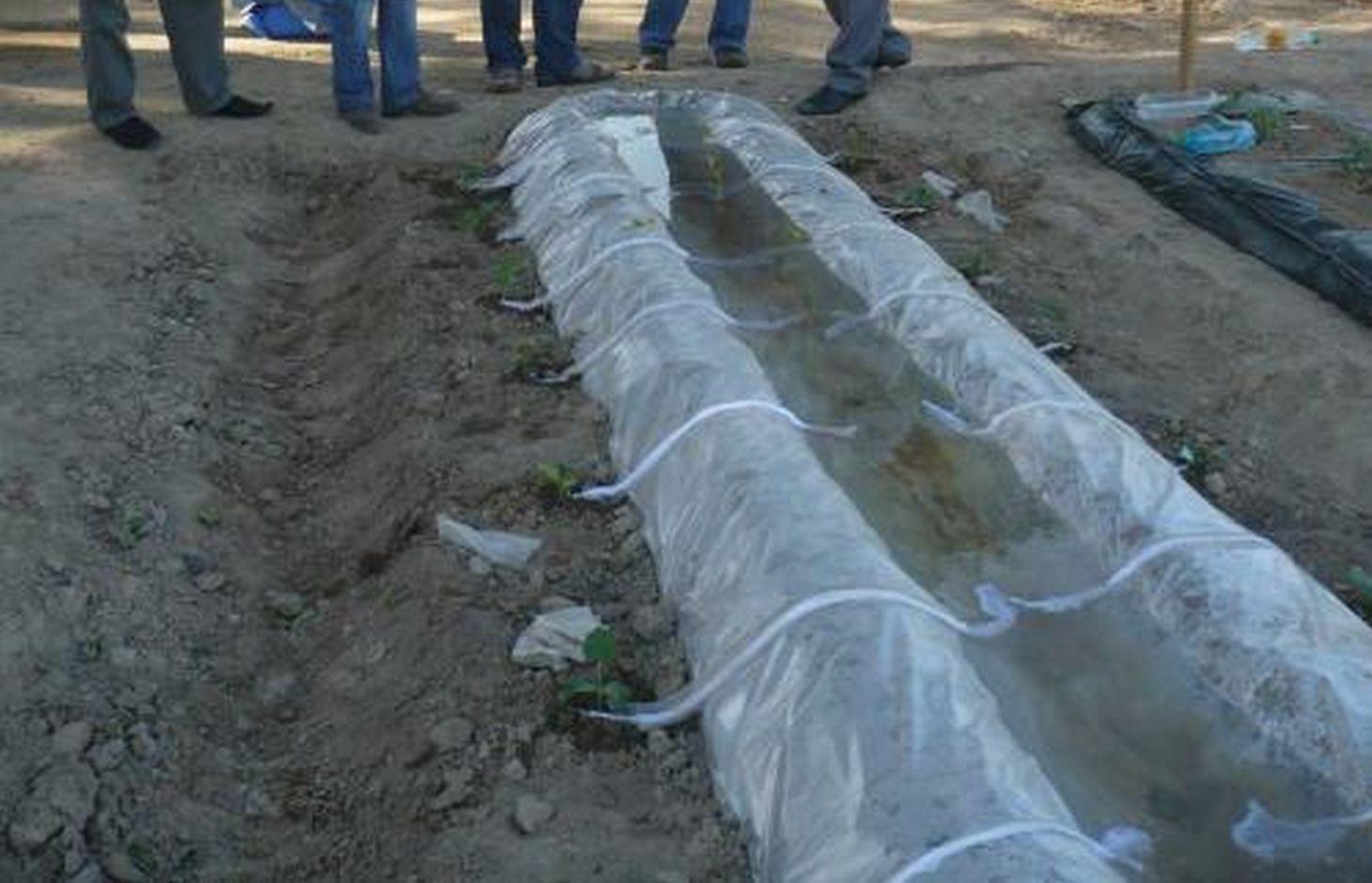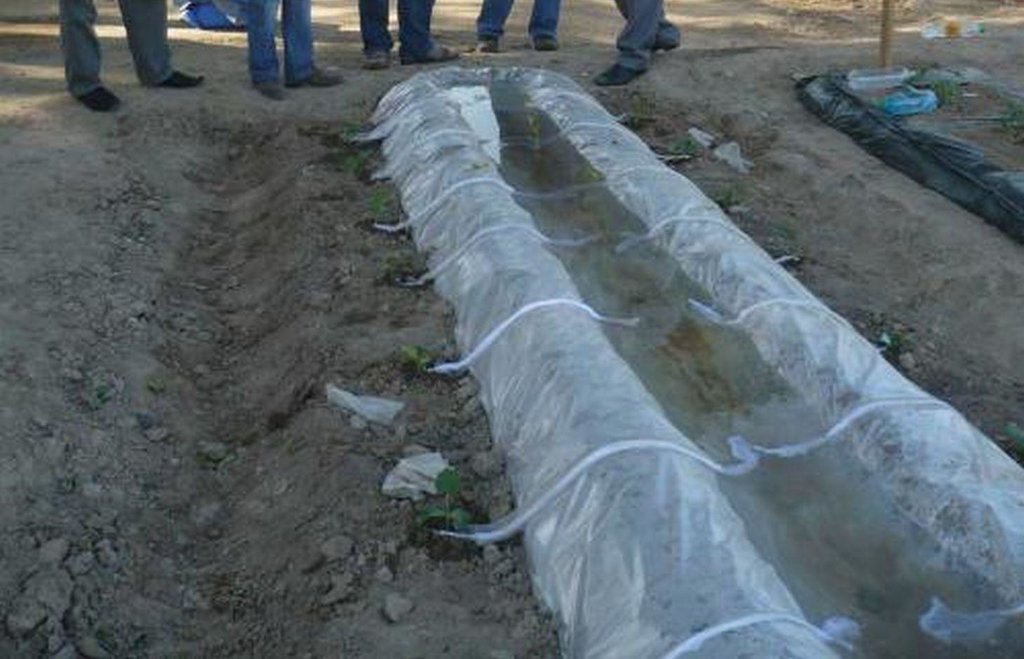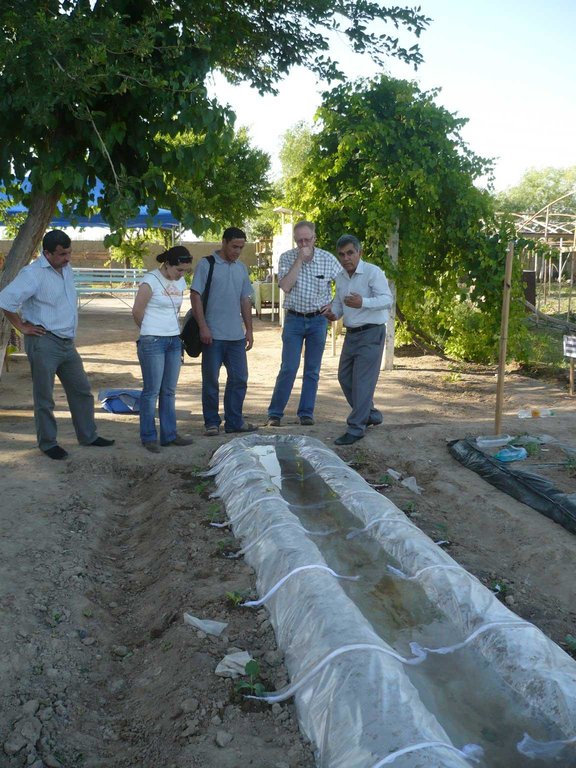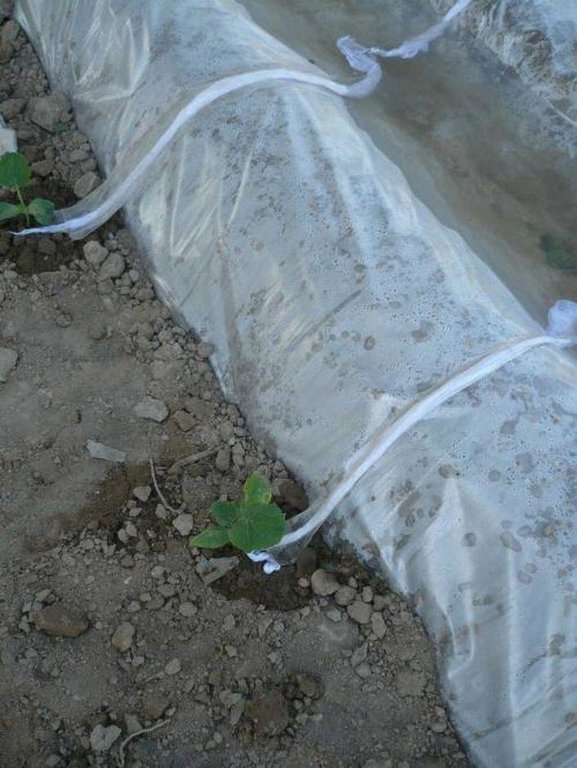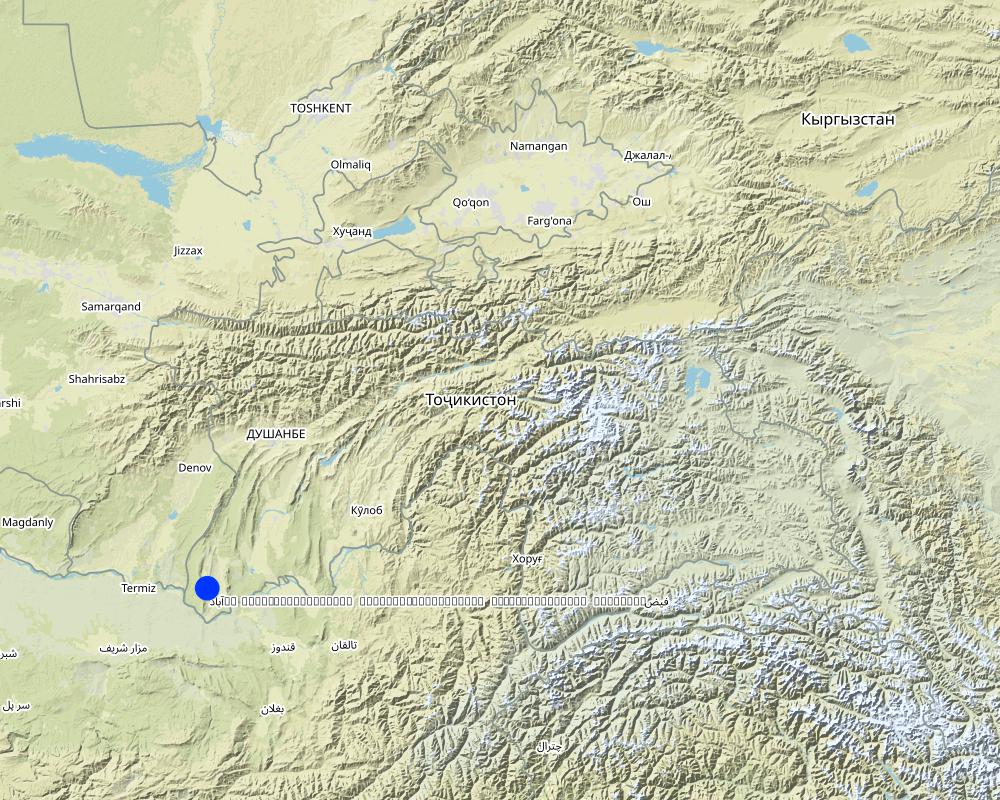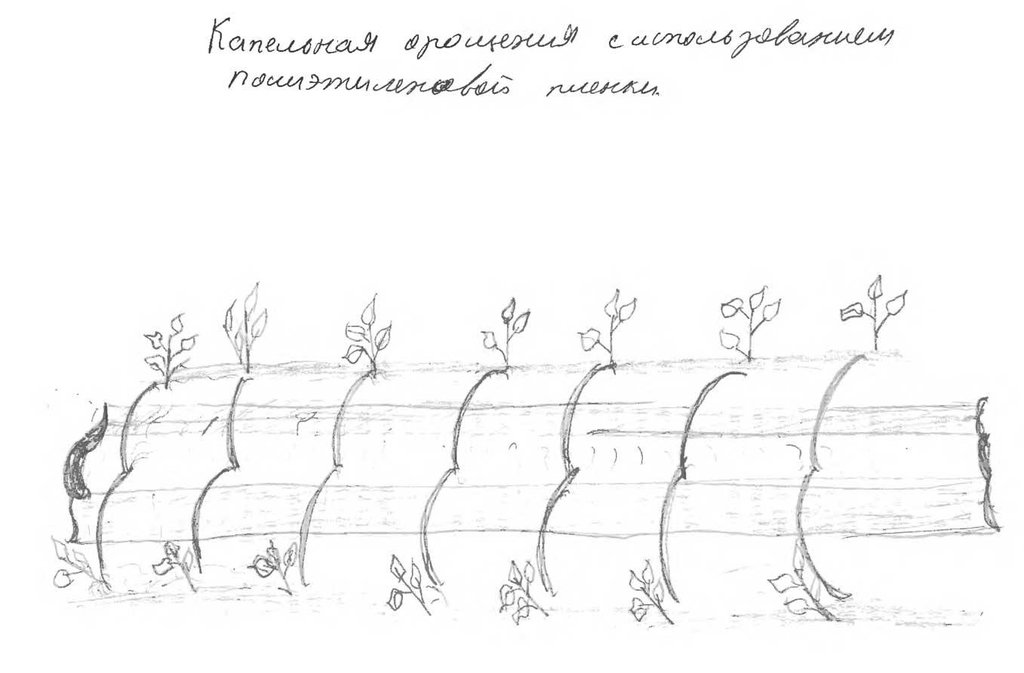Drip irrigation using polyethylene sheeting and intermittent cloth strips. [Tajikistan]
- Creation:
- Update:
- Compiler: Rustam Kalandarov
- Editor: –
- Reviewers: Alexandra Gavilano, David Streiff, Joana Eichenberger
technologies_1037 - Tajikistan
- Full summary as PDF
- Full summary as PDF for print
- Full summary in the browser
- Full summary (unformatted)
- Drip irrigation using polyethylene sheeting and intermittent cloth strips.: March 20, 2017 (inactive)
- Drip irrigation using polyethylene sheeting and intermittent cloth strips.: July 22, 2017 (inactive)
- Drip irrigation using polyethylene sheeting and intermittent cloth strips.: Aug. 21, 2019 (inactive)
- Drip irrigation using polyethylene sheeting and intermittent cloth strips.: Nov. 2, 2021 (public)
View sections
Expand all Collapse all1. General information
1.2 Contact details of resource persons and institutions involved in the assessment and documentation of the Technology
SLM specialist:
Name of project which facilitated the documentation/ evaluation of the Technology (if relevant)
Pilot Program for Climate Resilience, Tajikistan (WB / PPCR)Name of the institution(s) which facilitated the documentation/ evaluation of the Technology (if relevant)
Youth Ecological Center, Tajikistan (Youth Ecological Center, Tajikistan) - TajikistanName of the institution(s) which facilitated the documentation/ evaluation of the Technology (if relevant)
NCCR North-South (NCCR North-South) - Kyrgyzstan1.3 Conditions regarding the use of data documented through WOCAT
The compiler and key resource person(s) accept the conditions regarding the use of data documented through WOCAT:
Yes
2. Description of the SLM Technology
2.1 Short description of the Technology
Definition of the Technology:
Drip irrigation using polyethylene sheeting and intermittent cloth strips.
2.2 Detailed description of the Technology
Description:
Drip irrigation with polyethylene film was used in areas with extreme conditions who have poor irrigation water available for the cultivation of vegetables. The polyethylene film covers vegetable patches and is filled with water. Every plant is watered with the use of cloth strips which soak up the water. Roots of the plants are watered on a regular basis.
Purpose of the Technology: South of Khatlon lacks water, which is mainly used to irrigate the cotton plantations. Land users stored water in the tanks and used it for drip irrigation. The overall goal of the technology is to use water efficiently, to reduce evaporation and to prevent soil erosion. The technology is used to grow vegetables and tree plants.
Establishment / maintenance activities and inputs: Ploughing, digging patches, planting the plants, covering the patches with polyethylene sheet, filling with water. Every plant is watered with the use of cloth strips which soak up the water. This technology requires polyethylene sheeting, and cloth strips for drip irrigation.
Natural / human environment: Annual plants are grown under extreme climatic and unpredictable weather conditions, in saline soils and with poor irrigation water available
2.3 Photos of the Technology
2.5 Country/ region/ locations where the Technology has been applied and which are covered by this assessment
Country:
Tajikistan
Region/ State/ Province:
Tajikistan
Further specification of location:
Khatlon District, Nosiri Husrav region
Specify the spread of the Technology:
- evenly spread over an area
If precise area is not known, indicate approximate area covered:
- < 0.1 km2 (10 ha)
Comments:
Farmland
Map
×2.7 Introduction of the Technology
Specify how the Technology was introduced:
- during experiments/ research
Comments (type of project, etc.):
The technology has been used since 2007
3. Classification of the SLM Technology
3.1 Main purpose(s) of the Technology
- reduce water input
3.2 Current land use type(s) where the Technology is applied

Cropland
- Annual cropping
- tomatoes, cucumbers, peppers
Number of growing seasons per year:
- 2
Specify:
Longest growing period in days: 120Longest growing period from month to month: February - MaySecond longest growing period in days: 180Second longest growing period from month to month: June - November
Comments:
Major land use problems (compiler’s opinion): lack of irrigation water, high soil salinity, unpredictable weather conditions,
Major land use problems (land users’ perception): lack of irrigation water, high soil salinity, unpredictable weather conditions
3.4 Water supply
Water supply for the land on which the Technology is applied:
- full irrigation
Comments:
Водопотребление: полностью орошаемое
3.5 SLM group to which the Technology belongs
- irrigation management (incl. water supply, drainage)
3.6 SLM measures comprising the Technology

agronomic measures
- A7: Others

management measures
- M4: Major change in timing of activities
Comments:
Main measures: agronomic measures
Secondary measures: management measures
Type of agronomic measures: early planting, relay cropping, retaining more vegetation cover, mulching, green manure, legume inter-planting, manure / compost / residues
Type of vegetative measures: aligned: -contour
3.7 Main types of land degradation addressed by the Technology

soil erosion by water
- Wt: loss of topsoil/ surface erosion

chemical soil deterioration
- Cs: salinization/ alkalinization

physical soil deterioration
- Pk: slaking and crusting
- Pi: soil sealing

water degradation
- Hq: decline of groundwater quality
Comments:
Main type of degradation addressed: Wt: loss of topsoil / surface erosion, Cs: salinisation / alkalinisation, Ha: aridification
Secondary types of degradation addressed: Pk: sealing and crusting
Main causes of degradation: soil management, crop management (annual, perennial, tree/shrub), droughts
Secondary causes of degradation: change in temperature, labour availability
3.8 Prevention, reduction, or restoration of land degradation
Specify the goal of the Technology with regard to land degradation:
- prevent land degradation
- restore/ rehabilitate severely degraded land
Comments:
Main goals: rehabilitation / reclamation of denuded land
Secondary goals: prevention of land degradation
4. Technical specifications, implementation activities, inputs, and costs
4.1 Technical drawing of the Technology
Technical specifications (related to technical drawing):
Vegetable seedlings are planted in both sides of the patches, a polyethylene sheet is covered over the patches and filled in with water. A strip is directed toward each plant with one end in water and other - next to a plant. Watering takes place through the strips.
Location: Tajikistan. Khatlon District, Nosiri Husrav region
Date: May 3, 2011
Technical knowledge required for field staff / advisors: high
Technical knowledge required for land users: low
Main technical functions: increase / maintain water stored in soil, water harvesting / increase water supply
Aligned: -contour
Vegetative material: O : other
Number of plants per (ha): 1000
Vertical interval within rows / strips / blocks (m): 0.35
Width within rows / strips / blocks (m): 0.7
Trees/ shrubs species: tomatoes, cucumbers, peppers
Slope (which determines the spacing indicated above): 3%
If the original slope has changed as a result of the Technology, the slope today is (see figure below): 3%
Gradient along the rows / strips: 3%
Structural measure: Plantation on plain surface
Vertical interval between structures (m): 0.35
Spacing between structures (m): 0.35
Depth of ditches/pits/dams (m): 0.25
Width of ditches/pits/dams (m): 0.7
Length of ditches/pits/dams (m): 35
Height of bunds/banks/others (m): 0.4
Width of bunds/banks/others (m): 0.7
Length of bunds/banks/others (m): 0.5
Change of land use type: change in type of irrigation
Author:
Kalandarov R., Dushanbe, 3 Herzin street
4.2 General information regarding the calculation of inputs and costs
other/ national currency (specify):
Somoni
If relevant, indicate exchange rate from USD to local currency (e.g. 1 USD = 79.9 Brazilian Real): 1 USD =:
4.5
Indicate average wage cost of hired labour per day:
10.00
4.3 Establishment activities
| Activity | Timing (season) | |
|---|---|---|
| 1. | polyethylene sheet |
4.4 Costs and inputs needed for establishment
| Specify input | Unit | Quantity | Costs per Unit | Total costs per input | % of costs borne by land users | |
|---|---|---|---|---|---|---|
| Labour | Installing drip irrigation | Persons/day | 2.0 | 20.0 | 40.0 | 100.0 |
| Plant material | Seeds | ha | 1.0 | 25.0 | 25.0 | 100.0 |
| Construction material | Polyethylene sheet | ha | 1.0 | 32.0 | 32.0 | 100.0 |
| Construction material | Pipes and tools | ha | 1.0 | 400.0 | 400.0 | 100.0 |
| Total costs for establishment of the Technology | 497.0 | |||||
| Total costs for establishment of the Technology in USD | 110.44 | |||||
Comments:
Duration of establishment phase: 4 month(s)
4.5 Maintenance/ recurrent activities
| Activity | Timing/ frequency | |
|---|---|---|
| 1. | Preparation of soil | December |
| 2. | Planting seedlings or seeds (tomatoes, cucumbers, pepper) | spring |
| 3. | Agronomic work | march june |
4.6 Costs and inputs needed for maintenance/ recurrent activities (per year)
| Specify input | Unit | Quantity | Costs per Unit | Total costs per input | % of costs borne by land users | |
|---|---|---|---|---|---|---|
| Labour | Preparation of soil | Persons/day | 2.0 | 20.0 | 40.0 | 100.0 |
| Labour | Planting Sees | Persons/day | 2.0 | 20.0 | 40.0 | 100.0 |
| Labour | Agronomic work | Persons/day | 25.0 | 20.0 | 500.0 | 100.0 |
| Equipment | Tools | Pieces | 4.0 | 15.0 | 60.0 | 100.0 |
| Plant material | Seeds (tomatoes, cucumbers, pepper) | Gramm | 50.0 | 0.5 | 25.0 | 100.0 |
| Fertilizers and biocides | Compost/manure | kg | 500.0 | 0.4 | 200.0 | 100.0 |
| Total costs for maintenance of the Technology | 865.0 | |||||
| Total costs for maintenance of the Technology in USD | 192.22 | |||||
5. Natural and human environment
5.1 Climate
Annual rainfall
- < 250 mm
- 251-500 mm
- 501-750 mm
- 751-1,000 mm
- 1,001-1,500 mm
- 1,501-2,000 mm
- 2,001-3,000 mm
- 3,001-4,000 mm
- > 4,000 mm
Specifications/ comments on rainfall:
Precipitation 150-200mm
Agro-climatic zone
- arid
Thermal climate class: subtropics. Saline soil
5.2 Topography
Slopes on average:
- flat (0-2%)
- gentle (3-5%)
- moderate (6-10%)
- rolling (11-15%)
- hilly (16-30%)
- steep (31-60%)
- very steep (>60%)
Landforms:
- plateau/plains
- ridges
- mountain slopes
- hill slopes
- footslopes
- valley floors
Altitudinal zone:
- 0-100 m a.s.l.
- 101-500 m a.s.l.
- 501-1,000 m a.s.l.
- 1,001-1,500 m a.s.l.
- 1,501-2,000 m a.s.l.
- 2,001-2,500 m a.s.l.
- 2,501-3,000 m a.s.l.
- 3,001-4,000 m a.s.l.
- > 4,000 m a.s.l.
Comments and further specifications on topography:
Altitudinal zone: 374m above sea level
Landforms: The plot is on a plain
5.3 Soils
Soil depth on average:
- very shallow (0-20 cm)
- shallow (21-50 cm)
- moderately deep (51-80 cm)
- deep (81-120 cm)
- very deep (> 120 cm)
Soil texture (topsoil):
- medium (loamy, silty)
Topsoil organic matter:
- low (<1%)
If available, attach full soil description or specify the available information, e.g. soil type, soil PH/ acidity, Cation Exchange Capacity, nitrogen, salinity etc.
Soil fertility is low
Soil drainage / infiltration is medium and artificial
Soil water storage capacity is medium
5.4 Water availability and quality
Ground water table:
< 5 m
Availability of surface water:
medium
Water quality (untreated):
good drinking water
5.5 Biodiversity
Species diversity:
- medium
5.6 Characteristics of land users applying the Technology
Market orientation of production system:
- subsistence (self-supply)
- mixed (subsistence/ commercial)
Off-farm income:
- 10-50% of all income
Relative level of wealth:
- average
Individuals or groups:
- individual/ household
Level of mechanization:
- manual work
Gender:
- women
- men
Indicate other relevant characteristics of the land users:
Land users applying the Technology are mainly common / average land users
Population density: < 10 persons/km2
Annual population growth: < 0.5%
Market orientation of production system: Also commercial/ market
5.7 Average area of land used by land users applying the Technology
- < 0.5 ha
- 0.5-1 ha
- 1-2 ha
- 2-5 ha
- 5-15 ha
- 15-50 ha
- 50-100 ha
- 100-500 ha
- 500-1,000 ha
- 1,000-10,000 ha
- > 10,000 ha
Is this considered small-, medium- or large-scale (referring to local context)?
- medium-scale
5.8 Land ownership, land use rights, and water use rights
Land ownership:
- communal/ village
Land use rights:
- individual
Water use rights:
- individual
5.9 Access to services and infrastructure
health:
- poor
- moderate
- good
education:
- poor
- moderate
- good
employment (e.g. off-farm):
- poor
- moderate
- good
markets:
- poor
- moderate
- good
energy:
- poor
- moderate
- good
roads and transport:
- poor
- moderate
- good
drinking water and sanitation:
- poor
- moderate
- good
financial services:
- poor
- moderate
- good
6. Impacts and concluding statements
6.1 On-site impacts the Technology has shown
Socio-economic impacts
Production
crop production
risk of production failure
Socio-cultural impacts
food security/ self-sufficiency
conflict mitigation
Ecological impacts
Water cycle/ runoff
harvesting/ collection of water
excess water drainage
evaporation
Soil
soil crusting/ sealing
nutrient cycling/ recharge
salinity
Climate and disaster risk reduction
drought impacts
6.3 Exposure and sensitivity of the Technology to gradual climate change and climate-related extremes/ disasters (as perceived by land users)
Gradual climate change
Gradual climate change
| Season | increase or decrease | How does the Technology cope with it? | |
|---|---|---|---|
| annual temperature | increase | well |
Climate-related extremes (disasters)
Meteorological disasters
| How does the Technology cope with it? | |
|---|---|
| local rainstorm | not well |
| local windstorm | not well |
Climatological disasters
| How does the Technology cope with it? | |
|---|---|
| drought | well |
Hydrological disasters
| How does the Technology cope with it? | |
|---|---|
| general (river) flood | not well |
Other climate-related consequences
Other climate-related consequences
| How does the Technology cope with it? | |
|---|---|
| reduced growing period | well |
6.4 Cost-benefit analysis
How do the benefits compare with the establishment costs (from land users’ perspective)?
Short-term returns:
very positive
How do the benefits compare with the maintenance/ recurrent costs (from land users' perspective)?
Short-term returns:
very positive
6.5 Adoption of the Technology
If available, quantify (no. of households and/ or area covered):
NA
Comments:
Comments on acceptance with external material support: The technology is not widely used
Comments on spontaneous adoption: In one farm
Comments on adoption trend: Is being developed further
6.7 Strengths/ advantages/ opportunities of the Technology
| Strengths/ advantages/ opportunities in the land user’s view |
|---|
| This variant of drip irrigation is a low cost technology |
|
Higher crop yields are achieved How can they be sustained / enhanced? This technology helps preserve soil fertility and reduces the washout of nutrients |
| Strengths/ advantages/ opportunities in the compiler’s or other key resource person’s view |
|---|
| This variant of drip irrigation is a low cost technology |
|
Can be used in greenhouses and under extreme climatic conditions How can they be sustained / enhanced? Can be developed in changing climate conditions |
|
By reducing the amount of water used for irrigation the technology helps to save water How can they be sustained / enhanced? Water is available during the growing period |
|
As the technology is not labour intensive it can be readily used How can they be sustained / enhanced? The technology is not labour intensive |
| The technology is beneficial for the environment as it prevents soil degradation |
6.8 Weaknesses/ disadvantages/ risks of the Technology and ways of overcoming them
| Weaknesses/ disadvantages/ risks in the land user’s view | How can they be overcome? |
|---|---|
| Useless in open space with high temperatures | Applicable only in a suitable area |
| Weaknesses/ disadvantages/ risks in the compiler’s or other key resource person’s view | How can they be overcome? |
|---|---|
| Not appropriate for use in open spaces with high temperatures | Only apply in suitable area |
| The technology can be used for Solanaceae only | Being developed for other crops |
7. References and links
7.1 Methods/ sources of information
Links and modules
Expand all Collapse allLinks
No links
Modules
No modules


